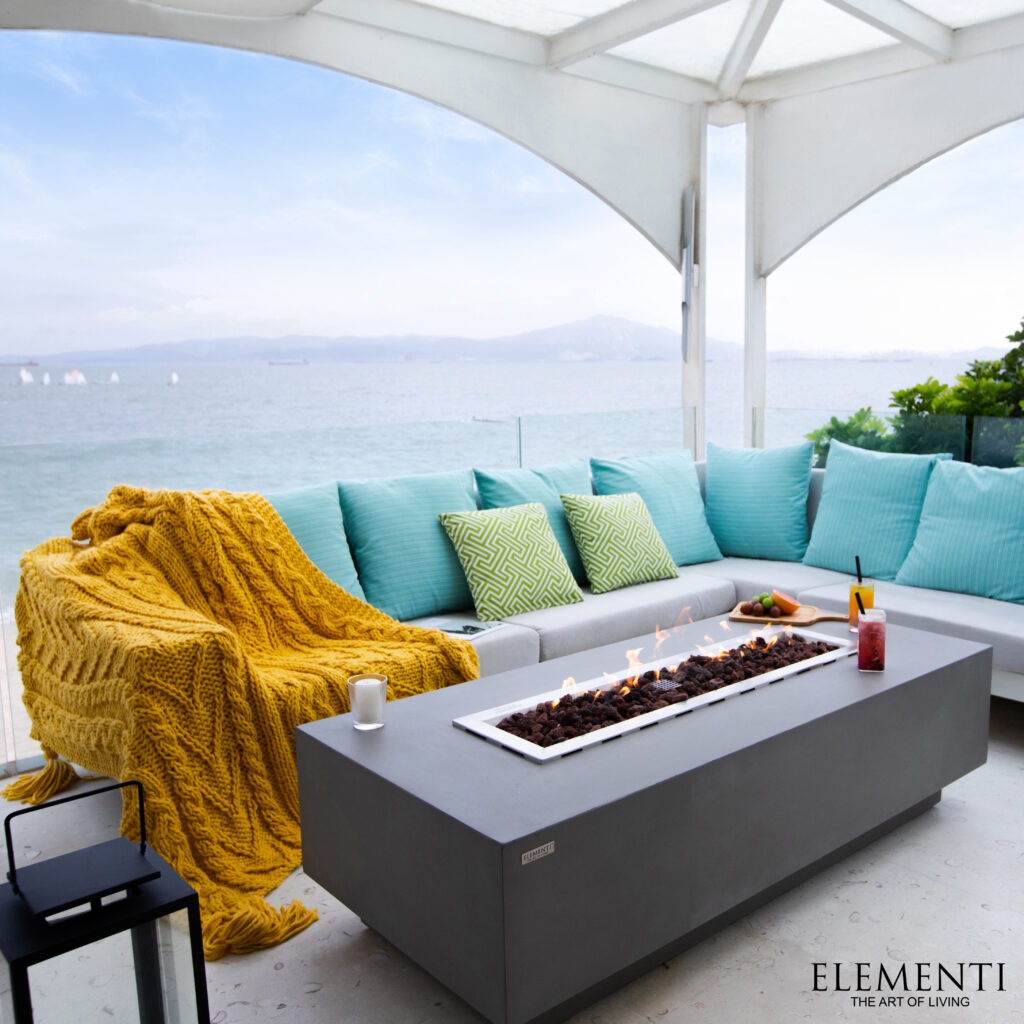Gas fire pits are becoming an increasingly popular feature for outdoor spaces, bringing warmth, ambiance, and functionality to any backyard or patio. Whether you’re looking to extend the usability of your outdoor area throughout the year or add a touch of luxury to your home, a gas fire pit is an excellent choice. In this guide, we will explore the benefits of fire pits, different types available, how to choose the best one, and key considerations for safe and effective use.
1. What Is a Gas Fire Pit?
A gas fire pit is an outdoor fixture that burns either propane or natural gas to produce a controlled flame, mimicking the warm and inviting atmosphere of a traditional wood fire. Unlike wood-burning fire pits, gas fire pits offer a cleaner burn with less smoke, are easier to control, and typically require less maintenance.
Fire pits can vary in size, shape, material, and style, allowing homeowners to customize the design to complement their outdoor decor. These fire pits are ideal for patios, decks, gardens, and other outdoor gathering areas, creating a focal point for entertaining or relaxing.
2. Benefits of Gas Fire Pits
Fire pits offer a wide range of advantages over traditional wood-burning alternatives. Here are some key benefits:
Convenience and Ease of Use
One of the biggest advantages of fire pits is how easy they are to use. There’s no need to gather wood, wait for it to catch fire, or deal with the mess of ashes afterward. With the flick of a switch or the turn of a knob, you can ignite a gas fire pit instantly, providing immediate warmth and ambiance.
Clean Burning
Unlike wood fires that produce smoke, embers, and ash, gas fire pits burn cleanly. This makes them more environmentally friendly and far less disruptive to the comfort of your outdoor space. Guests can enjoy the warmth of the fire without worrying about smoke getting in their eyes or on their clothes.
Safety
Gas fire pits are generally safer than wood-burning options. The flames are more controlled, and there’s no risk of embers or sparks flying into the air, which can sometimes pose a fire hazard. Additionally, many fire pits come with safety features like automatic shut-off valves or flame control systems to further reduce risks.
Customizable Design
Fire pits come in a variety of styles, shapes, and sizes. From sleek, modern designs to rustic, stone finishes, homeowners can choose a fire pit that complements their existing outdoor decor. You can also select different types of gas burners, including linear, round, or square, to further customize the look and functionality of your fire pit.
Year-Round Usability
Unlike wood-burning fires that can be uncomfortable in warm weather, fire pits can be adjusted to provide just the right amount of heat, making them suitable for year-round use. In cooler months, the fire pit can create a cozy outdoor space for gatherings, while in warmer weather, the flames can be kept low for ambiance without overwhelming heat.
3. Types of Gas Fire Pits
Fire pits come in a variety of designs and fuel options, making it easier for homeowners to find a model that fits their space and needs. The two main types of gas fire pits are propane and natural gas.
Propane Fire Pits
Propane fire pits are powered by liquid propane gas, which is typically stored in a tank that can be hidden within the structure of the fire pit. Propane fire pits are popular for their portability, as they can be moved around to different locations in your backyard or patio. They’re also a great option for people who do not have access to a natural gas line.
Advantages of propane fire pits:
- Easy to move and put wherever you like.
- Easy to set up without the need for a permanent gas line.
- Convenient and widely available fuel source.
Natural Gas Fire Pits
Natural gas fire pits are connected to a natural gas line, providing a consistent and steady fuel source. Because they are hooked into a home’s gas supply, these fire pits are usually permanent installations. They are perfect for homeowners who prefer a stationary fire feature in their outdoor living space.
Advantages of natural gas:
- Cost-effective if you already have a natural gas line installed.
- No need to refill gas tanks.
- Burns cleaner and more efficiently than propane.
4. Choosing the Right Gas Fire Pit
When shopping for a gas fire pit, there are several factors to consider to ensure that you select the right model for your needs. From size and fuel type to style and safety features, here’s what you should think about when choosing a gas fire pit.
Size and Shape
The size and shape of your gas fire pit will depend on the layout of your outdoor space and how you plan to use the fire pit. If you’re working with a smaller patio, you might want a compact, round fire pit, whereas larger backyards can accommodate rectangular or square designs that seat more people around them.
Measure the space where you plan to install your fire pit, ensuring that you leave enough room for seating and movement around the fire pit. Consider both the height and width of the fire pit to ensure that it fits harmoniously into your outdoor area.
Material
Fire pits are constructed from a variety of materials, each with its own aesthetic and durability characteristics. The most common materials include:
- Steel: Lightweight, durable, and often powder-coated for weather resistance.
- Aluminum: Rust-resistant and easy to move, ideal for portable fire pits.
- Stone: Natural and rustic, stone fire pits blend well with outdoor environments.
- Concrete: Sleek and modern, offering a contemporary look.
Choose a material that suits the style of your outdoor space while also being durable enough to withstand the elements.
Heat Output
The heat output of a gas fire pit is measured in BTUs (British Thermal Units), which indicates how much heat the fire pit can produce. A higher BTU rating means more heat. If you live in a cooler climate or plan to use the fire pit as a primary heat source for your outdoor area, opt for a model with a higher BTU output. Typical fire pits range between 30,000 and 100,000 BTUs.
Fuel Type
Decide whether you prefer a propane or natural gas fire pit, as each has its pros and cons. Propane is portable and doesn’t require a gas line, but you’ll need to periodically replace the propane tank. Natural gas is more cost-effective over time and doesn’t require refueling, but it will require a permanent gas line installation.
Ignition System
There are two main types of ignition systems for gas: manual and automatic.
- Manual Ignition: Requires you to light the fire pit with a lighter or match after turning on the gas. This is a simple and budget-friendly option.
- Automatic Ignition: Comes with a built-in ignition system that allows you to start the fire pit with the push of a button. These systems are more convenient and often come with added safety features like flame control and automatic shut-off.
5. Key Safety Considerations
While gas fire pits are generally safer than wood-burning alternatives, there are still important safety considerations to keep in mind.
Proper Ventilation
Always ensure that your gas fire pit is installed in an open area with proper ventilation. Fire pits require adequate airflow to operate safely and prevent the buildup of dangerous gases like carbon monoxide.
Distance from Flammable Materials
Your fire pit should be placed a safe distance from any flammable materials, including plants, trees, and patio furniture. Most manufacturers recommend keeping a minimum clearance of 10 feet between the fire pit and any structures.
Regular Maintenance
Regular maintenance is essential for keeping your gas fire pit operating safely. Clean out any debris that might accumulate around the burner, check for gas leaks, and inspect the ignition system regularly.
Gas Line Installation
If you’re installing a natural gas fire pit, it’s crucial to have a licensed professional install the gas line. This ensures that the installation is up to code and reduces the risk of gas leaks.
6. Enhancing Your Outdoor Space with a Gas Fire Pit
Beyond functionality, gas fire pits can significantly enhance the ambiance and aesthetics of your outdoor living area. Here are some ways you can elevate your space:
Seating Arrangement
Arrange comfortable outdoor seating around your gas fire pit to create a cozy and inviting gathering spot. Opt for durable outdoor furniture that complements the style of your fire pit. Consider adding cushions or blankets for extra comfort during cooler months.
Fire Glass and Lava Rock
Enhance the look of your gas fire pit by adding decorative fire glass or lava rocks to the burner area. These materials not only improve the appearance of the fire pit but also help to distribute heat more evenly.
Lighting and Landscaping
Incorporate ambient lighting around your fire pit area to create a warm and welcoming atmosphere. Path lights, string lights, or lanterns can enhance the mood and make the area feel like an extension of your indoor living space. Additionally, landscaping with plants, shrubs, or even water features can make your fire pit area feel more integrated with the natural surroundings.
Conclusion
A gas fire pit is a fantastic addition to any outdoor space, providing warmth, ambiance, and a central gathering spot for family and friends. Whether you choose a propane or natural gas model, a fire pit offers convenience, safety, and the versatility to enjoy your outdoor area year-round. By carefully considering size, material, heat output, and safety features, you can find the perfect gas fire pit to transform your backyard into a stylish and functional outdoor retreat.
Investing in a gas fire pit is not just about adding warmth; it’s about creating memorable experiences outdoors—whether it’s roasting marshmallows with the kids, entertaining friends, or simply relaxing by the fire after a long day. With the right fire pit, your outdoor space becomes a true extension of your home.


